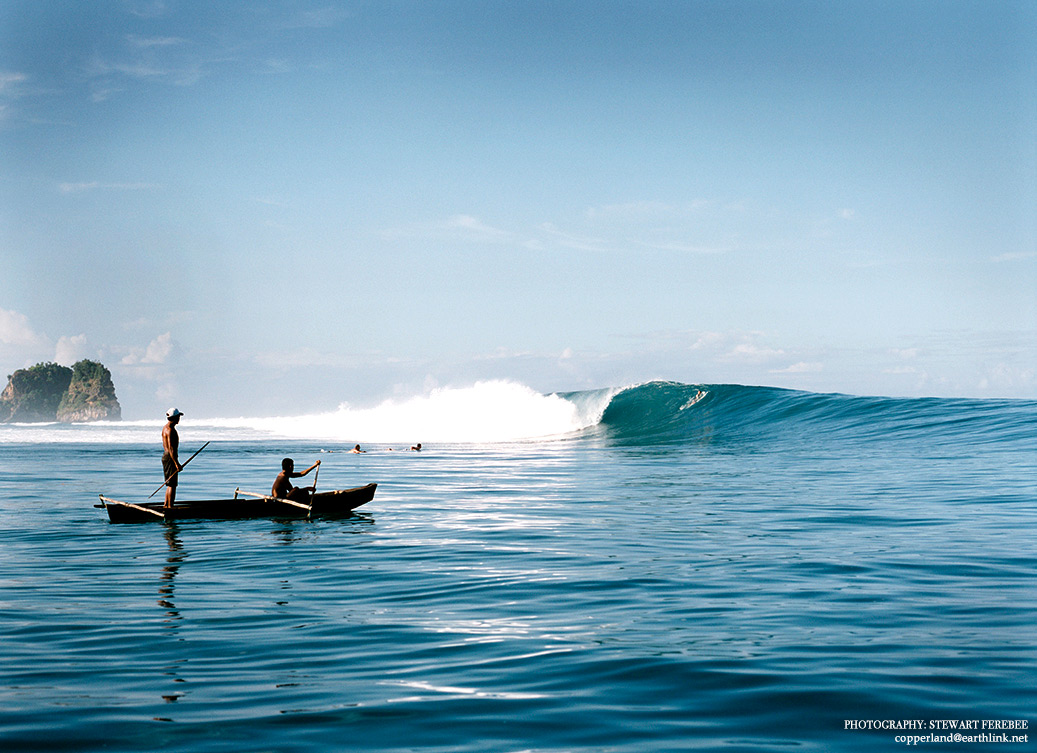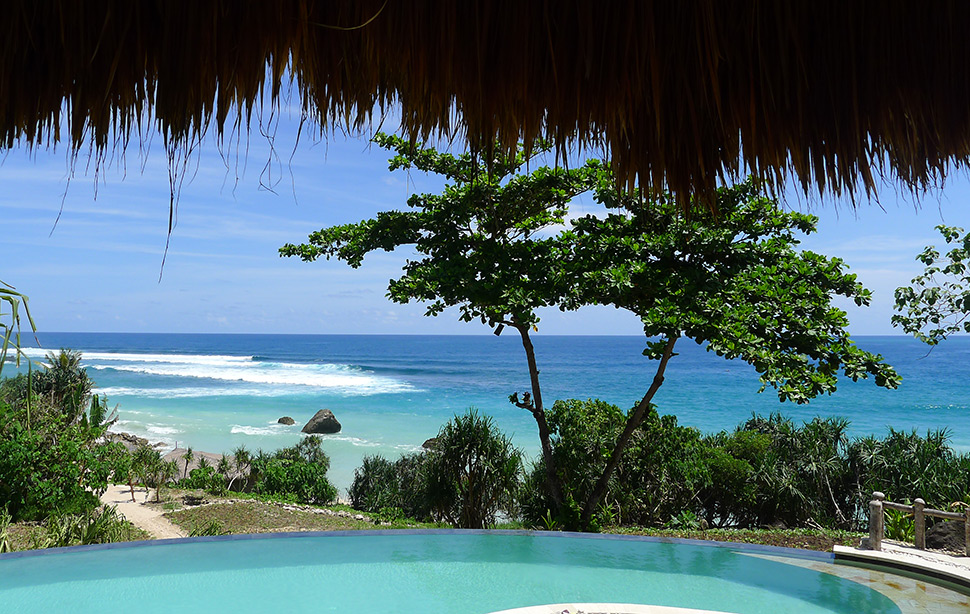Nihiwatu / Indonesia – Surf – Sumba Island

 Surfergalaxy
Surfergalaxy 
| Wave | Left |
| Ola | Izquierda |
| Wind | NE |
| Tide | All |
| Marea | Todas |
| Swell | SW - S |
| Bottom | Coral reef |
| Fondo | Arrecife de Coral |
| Time of year | From March to November |
| Época del año | Desde Marzo a Noviembre |
It’s a fast wave like any other Indonesian reef break and it starts to work with four feet, properly with more than six. Although the tides there don’t change much, you should be aware at the times of spring tides when the conditions can change noticeably as at low tide the take-off zone collects a lot of water making the drop a little more critical and if it’s a good size you won’t be able to do manoeuvers unless you’re fast.
With low tide, you need to go down the line and with full tide it’s fun and rideable. With the most extreme spring tides, only the last section rideable during low tide, and it’s the opposite in times of dead tides when the wave hardly changes. From March to November is the most consistent season, and there can even be swells of more than 12 feet. But during these months, it’s important to get up early because the SE winds here are cross-shore and persistent during the midday hours. This complicates the ride but the wall keeps its shape and even sometimes produces good barrels.
La ola es rápida como cualquier reefbreak indonesio, empieza a funcionar con 4 pies y propiamente con más de seis. Aunque las mareas no poseen mucha amplitud, debes estar atento a los periodos de mareas vivas cuando las condiciones pueden cambiar notablemente. Con marea baja y un tamaño medio, la zona de take off recoge mucha agua haciendo el drop crítico, con más tamaño no habrá tregua para maniobras a no ser que seas rápido.
Con marea baja hay que ir rápido pasando secciones y con marea llena es muy divertida y surfeable. Verás que con las mareas vivas más extremas la marea baja hace solo surfeable la sección final de la ola, lo contrario en periodos de mareas muertas que ola no cambia prácticamente.
Desde marzo a noviembre tienes la temporada más consistente, incluso puede entrar en alguna ocasión un swell de más de 12 pies, pero en estos meses lo más importante es madrugar porque los vientos side shore del SE son persistentes durante las horas centrales del día, complican el surf pero el fondo es bueno y la pared mantiene buena forma e incluso ofrece algún tubo.

The Nihiwatu left, which is translated as ‘God’s Left’ is located in Sumba, one of the most remote islands in Indonesia. There, in a remote place where few have been, breaking one hundred metres away from Paha Beach is one of the most beautiful places and lefts in the world.
Nihiwatu is a very consistent wave and its exposed reef benefits from any swell that forms from the Antarctic latitudes in the Indian Ocean. You can be sure that if there aren’t any waves at this left, then there won’t be any at all nearby, and you can also be sure that if there’s a good quality swell in Sumba, Nihiwatu is the best spot to be, some now called it the Macaronis in the south of Indonesia. To get there, the easiest way is to fly from Bali’s domestic airport to Tambolaka airport in Sumba which is an hour and a half away from Nihiwatu. Once you’re there, the only option is to stay in the Resort which is under the same management as the whole island, meaning that you’ll share your sessions with no more than ten people.
This type of environmental management is quite a controversial topic in today’s surfing and there are many people who are against it, believing that it doesn’t respect the principals of the sport. In response to this, the Resort management and the Sumba Foundation opened its doors to show everyone all of the mechanisms of a program that is directed at improving the lives of the local population without affecting the roots of their culture. They defended sustainable development and social conscience based on the equal distribution of the benefits to make the most of the available resources. This reason makes the cost prohibitive, which is frustrating for most surfers, and the only consolation is that the funds go to medicine, education, water, food and work for all of the local community.
En Sumba, una de las más remotas islas de Indonesia, se encuentra una izquierda llamada, según la lengua local, Nihiwatu o la ‘Izquierda de Dios’. Allí, en un lugar apartado donde pocos han llegado, rompe esta ola a cien metros de la playa de Paha, sin duda uno de los lugares e izquierdas más bonitas del mundo.
Nihiwatu es una ola muy consistente, se beneficia de la exposición de su arrecife a cualquier swell formado en cualquier lugar desde latitudes antárticas en el Océano Indico. Puedes estar seguro que si en esta izquierda no hay olas, no habrá en ningún sitio cercano. También puedes estar seguro que si hay buenas olas este es el mejor spot de Sumba, algunos ya lo llaman el Macaronis del sur de Indonesia. Para llegar, lo más fácil es volar desde el aeropuerto domestico de Bali hasta el aeropuerto de Tambolaka, en Sumba, que se sitúa a hora y media de Nihiwatu. Una vez allí, la única opción es quedarse en el resort que se ha hecho con la gestión de todo el entorno, esto significa que compartirás tus sesiones con no más de diez personas.
Hay que decir que este tipo de gestiones del entorno natural son algunas de las más polémicas del Surfing actual, son muchos los que se oponen a ellas porque no respetan los principios del deporte. A ello, los gestores del Resort y la fundación Sumba, responden abriendo sus puertas a mostrar todos los mecanismos de un programa que va dirigido a mejorar la vida de la población local sin alterar las raíces de su cultura. Defienden un desarrollo sostenible y de conciencia social basado en la distribución equitativa de los beneficios por el aprovechamiento de los recursos disponibles. Esta razón hace prohibitivo el coste del viaje siendo frustrante para la mayoría de surfistas, solo queda el consuelo de que ese elevado coste va dirigido a medicinas, educación, agua, alimentación y empleo para toda la comunidad local.
The World Wildlife Foundation classified Sumba as a unique ecological region thanks to its special flora and fauna that you can see in the Laiwangi Wanggameti and the Manupeu Tanah Daru National Parks. You’ll soon see why nothing has changed on this island. To explore isn’t easy, the roads are nearly inexistent, mostly unsurfaced and muddy. It’s such a virgin place that when you go on a trip, the silence with just the sounds of the jungle in the background is a strange experience. It’ll make you feel like you’ve stepped into private property or a sacred land and like in the films, a tribe could jump out and surprise you at any moment.
The truth is that the times of wars between the tribes and clans, and when the chiefs and the strongest warriors collected the heads of the defeated are long gone, however, what you will experience are, like most traditions, those that still exist from an immemorial time, mainly due to the isolation that the island is subjected to. Everything there is different from the rest of Indonesia, the language, the religion, the architecture, etc. Any activity that you do will be related to nature, for example, horse riding with the native Sumba horses, mountain bike routes, treks through the jungle where you’ll see hidden waterfalls, or visits to traditional villages. Fishing and scuba diving are also very important here.
El Fondo Mundial para la Naturaleza clasifica Sumba como una región ecológica única debido a su flora y fauna especiales que podrás conocer en el Parque Nacional Laiwangi Wanggameti y el Parque Nacional Manupeu Tanah Daru. Pronto te darás cuenta de porqué en esta isla nada ha cambiado, explorar cualquier lugar no es tarea fácil, los caminos son casi inexistentes, embarrados y muy pocos asfaltados. Es tan virgen que en cuanto hagas alguna ruta, el extraño silencio y el sonido de la jungla, hará que parezca que invades una propiedad privada o alguna tierra sagrada y, como si fuera una película, en cualquier momento una tribu te fuera a asaltar.
La verdad que muy atrás quedan los tiempos en los que antiguas guerras entre tribus y clanes, los jefes y los más fuertes guerreros coleccionaban las cabezas de los vencidos, sin embargo, lo que si vas a experimentar es como una mayoría de tradiciones aún siguen vigentes desde tiempo inmemorial, sobre todo debido al aislamiento al que está sometido esta isla. Aquí todo es distinto al resto de Indonesia, el idioma, la religión, la arquitectura, etc. Cualquier actividad que realices será en estrecha relación con la naturaleza, por ejemplo, paseos en los caballos autóctonos de Sumba, muy ligados a su cultura tanto ceremonial como ganadera, rutas en bicicleta de montaña, rutas por la jungla que te lleven a ver escondidas cascadas o visitas a algunos pueblos tradicionales de Sumba y no puedes olvidar también que el buceo y la pesca son muy importantes.